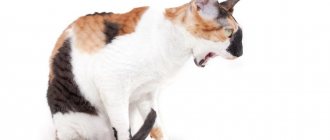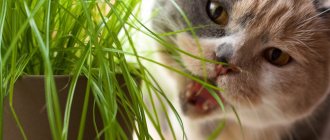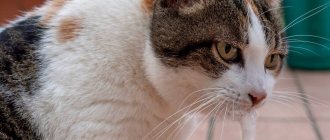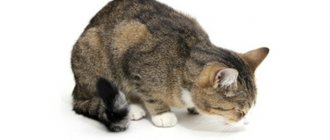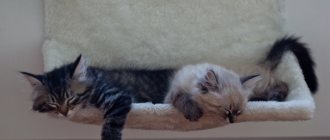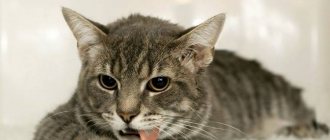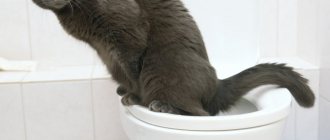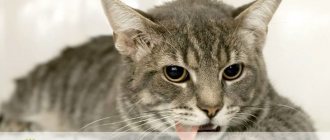Vomiting is one of the main protective reflexes of the gastrointestinal tract in animals. In this way, the body tries to get rid of mechanical, chemical irritants, foreign bodies and toxins. Seeing that his pet is vomiting, any owner will be alarmed and wonder why the cat is vomiting white foam and how to help the pet. When a cat vomits in white foam, this is one of the reactions of the cat’s body and there are many reasons for this. You should consider all possible options and choose the right algorithm of action , since you can miss the onset of the disease and lose favorable time for its rapid treatment.
If a cat vomits pure white foam , this is a sign of an empty stomach.
, which contains only hydrochloric acid, the secretion of the salivary glands and gastric enzymes.
When this mixture comes into contact with air, it foams. Often a cat vomits white foam on an empty stomach, for example, in the morning before you feed it. If this happens once , then most likely there is no cause for concern
and your cat is completely healthy.
Worry when
This symptom occurs repeatedly and is accompanied by other signs:
- in addition to vomiting, the animal refuses to eat;
- the foam has a pinkish tint, that is, stained with blood;
- vomiting accompanied by diarrhea;
- the cat is lethargic, depressed, apathetic;
- foul odor of vomit;
- the temperature rises or falls.
Differences between vomiting and regurgitation
A cat's vomiting of undigested food is the most common sign of illness. There are processes that look similar to vomiting, but which are not vomiting. The owner should differentiate between regurgitation and vomiting in order to describe the symptoms to the veterinarian. This is what will help the doctor make the correct diagnosis.
Vomiting is a reflex eruption of stomach contents. Its predecessor is nausea, which worries the animal. The cat begins to meow and back away, as if it cannot find a place for itself. At some point the pet hunches over and lowers its head. The owner may notice excessive salivation. Vomiting is accompanied by characteristic sounds. The masses contain remnants of undigested food, as well as bile.
Attacks occurring once every 4-5 days are considered normal. However, to understand the causes of vomiting, you need to reconsider your pet’s diet.
Sometimes cats vomit food, but owners mistake it for vomiting. Regurgitation is a process that occurs due to a spasm in the stomach. It begins immediately after eating or drinking water. Before and during regurgitation there is no salivation and nausea. The food comes out undigested, with an unpleasant odor and streaked with blood.
Most often, regurgitation is not of a threatening nature, but if the process is repeated several times a day, then the pet should be shown to a doctor.
Hairballs
Trying to remove hairballs from the stomach, the animal makes “coughing” sounds, as if it is suffocating. Before the fur comes out, the cat vomits a clear liquid - vomits stomach acid that looks like water.
Hairballs accumulate in a cat's stomach because she licks her fur while grooming herself. Her tongue contains many abrasive taste buds, collecting a lot of hair, which the cat then swallows. The hair mixes with the contents of the stomach and can form a dense hair ball that cannot be digested, and over time the cat begins to vomit.
If your cat frequently vomits water (a clear liquid) and the fur does not come out, you should immediately visit a veterinarian to determine the cause of the vomiting.
What to do if your cat vomits after eating undigested food
If a cat vomits after eating food, and the process occurs almost every day for 2-3 days, the owner should take the animal to the veterinarian. If it is not possible to see a doctor in the near future, you can provide first aid to your pet yourself.
The first thing to do is limit your cat's access to food and water. Even a very small amount of food will again provoke vomiting.
It is forbidden to force a cat to drink water and eat, otherwise the attack will return, and this will deprive the body even more. If your pet is constantly burping and its condition is getting worse, you should not postpone a visit to the doctor.
You should not self-medicate, especially if a kitten or an elderly cat has vomited. At this age, the animal’s immunity is reduced, so it is most susceptible to various diseases.
If the owner constantly feeds the animal with dry diets, then the cat’s digestion malfunctions. The pet vomits from dry food due to lack of fluid and lack of soft meat food.
Feed your cat more often, but less
If the cat feels sick and then vomits food, then it is necessary to resort to therapeutic fasting. Food is removed for 12-24 hours, and after a day they are fed often, but in very small portions.
If health improves and there are no urges, the pet is transferred to a gentle diet. Portions of the usual food are reduced by half, but fed no more than 4 times a day.
What to feed your cat
For a cat to feel good, it is necessary to feed it high-quality food. At the same time, the owner can boil meat and vegetables for the animal. The diet should also include fish.
If the pet eats foods that the owner himself eats, then there is no need to wean him off them. Don't forget to place a bowl of fresh water next to the food bowl.
In order not to provoke another urge, raw foods are removed from the diet.
Natural Causes of White Vomit
The gag reflex and the secretion of white foam in animals are an important defense mechanism against environmental factors, allowing them to get rid of unnecessary and harmful contents of their stomach.
A cat vomiting white foam – causes:
- Wool . Cats belong to the category of clean animals that often lick their skin and keep it neat. Over time, a whole ball of fur accumulates in the animal’s stomach, which provokes foam from the mouth and white vomit. It is recommended that pets with long and thick hair be given special medications (grass, tablets and pastes) to improve the removal of the hairball from the stomach, otherwise health problems cannot be avoided.
- Feed _ It happens that a cat vomits white foam after he has eaten dry food. This happens because dry food swells greatly in the stomach, and it rejects excess food. Dry feeding for cats always requires clean drinking water nearby.
- Hunger . The cat breed is sensitive to lack of food; their digestive system will synthesize all the necessary enzymes and secretions, even if the cat has been hungry for several days. The hydrochloric acid of the gastric juice irritates the mucous membranes of the organs and digestive sections - hence the white foam with vomiting. Your pet shouldn't go hungry!
- Binge eating . Some pets are unable to control the amount of food they eat, so they overeat, then white foam leaves the mouth and a gag reflex occurs due to the excess of undigested food. Swallowing food too quickly without sufficiently chewing chunks and lumps of food can also result in it being rejected from the stomach through the mouth and nose. A distinctive feature of this condition is the presence of pieces of food, white foam and mucus in the vomit.
- Foreign body . Cats are curious and need to taste everything. A pet can swallow any household item, followed by white foam and active vomiting, after which the animal becomes the same – cheerful, affectionate and playful. It’s worse if the pet has eaten or licked medications, chemicals, poisonous or poisonous substances, then unpleasant consequences cannot be avoided.
- Pregnancy . Cats, like women, always feel sick and vomit in the early stages of pregnancy. This is the result of changes in hormonal levels, which is considered normal, and therefore should not cause unnecessary concern to the owners. The gag reflex with white foam can also occur in the last stage of pregnancy, this is due to the voluminous uterus and its pressure on the cat’s digestive organs.
- In heat . Every living creature has an instinct for procreation, and the cat breed is no exception. On average, they come into heat 3-4 times a year, and the animal is distinguished by special behavior. The estrus stage of estrus may be accompanied by nausea, foaming and white vomit.
- Medicines . A pet may react with white foam after taking medications that are prescribed to animals by veterinarians during illnesses and for their prevention. White foam may occur in your pet after taking strong antibiotics. White vomiting can also be caused by Duphalac, which is recommended for animals as a laxative for constipation. A cat may also vomit with white foam from deworming medications.
- Stress . Poor health and nausea can occur against the background of an imbalance in the pet’s psychological state. Fear, changes in living conditions, excitement and other stressful situations in an animal can lead to nausea and vomiting.
© shutterstock
Attention! To avoid the nausea reflex from dry food, alternate it with natural food, periodically change the type of food and always leave fresh water for your pet.
Vomiting: its causes and dangers
Most often, vomiting is a sign of disturbances in the gastrointestinal tract. However, there are several reasons when the urge occurs against the background of other body processes. For example, during pregnancy, a cat’s internal organs are compressed, and the stomach cannot accommodate the usual amount of food. Another reason why a pregnant cat vomits is toxicosis. But this does not mean at all that she was not poisoned or her gastritis did not worsen.
Sometimes owners are perplexed why a healthy and active cat vomits food. Urging often occurs due to stress, especially if some kind of shock has occurred in the animal’s life.
Parasites are another reason why your cat vomits yellow mucus. Only a consultation with a veterinarian will help you cope with worms.
Binge eating
If the owner neglects the recommendations of the food manufacturer regarding feeding standards, then the cause of vomiting in the cat is overeating. Dry food seems light to owners, which means that a lot of granules are required to satiate the pet.
Once in the stomach, the particles swell, causing heaviness in the stomach. To avoid this, the owner should adhere to dosages and not exceed the daily allowance.
The cat eats too fast
If an animal swallows dry granules too quickly, it begins to vomit. This behavior is caused by competition that arises from living with another pet in the same house.
If your pet eats food without chewing, then you should start feeding it in another room, separate from other cats. You can also solve the problem by purchasing a bowl with ridges that slow down the absorption of food.
Abrupt change of feed
If a cat vomits after a new dry food, then it is possible that the matter is due to a sudden change in manufacturer. The new diet should be introduced gradually, mixing it with the usual food over the course of a week.
Vomiting may occur due to different compositions. For example, if the previous food contained mainly cereals, and the new food contained meat products. In this case, the body needs time to absorb the new type of protein.
Dry food is expired or spoiled
If your pet is vomiting daily, you should check the expiration date of the food on the packaging. If the date corresponds to the norm, it means that the food has spoiled for other reasons.
Dry rations often spoil due to poor storage conditions. The unsuitability of pellets for feeding is indicated by a sour smell and the presence of mold. In this case, it is easier to throw away the packaging and buy a new one. Before purchasing, you should always check the expiration date and integrity of the packaging.
The food is not suitable for the animal
Situations often arise when high-quality food is not suitable for a pet, causing food intolerance. Vomiting and diarrhea indicate this.
Most often, vomiting is provoked not by the food itself, but by the ingredients included in its composition. As a rule, these are sources of protein. Having selected a diet that does not contain the problematic component, the owner will be able to continue feeding the animal dry food.
The cat ate the food together with another product
Sometimes a pet refuses to eat food, so owners mix it with natural products. Different foods are digested differently. For example, an acidic environment is required to break down meat, which cannot be said about digesting a dry diet in which the proteins are denatured.
Mixing components that are incompatible with each other stops the stomach from working. The body begins to get rid of undigested food, vomiting occurs.
Hairballs in the stomach
Hairballs stuck in the stomach cause vomiting. When a pet is hungry, he does not feel discomfort, but as soon as he has lunch, his stomach cramps. Lumps prevent food from being digested normally, so the body tries to get rid of them.
Similar problems often occur in cats of long-haired breeds. Sometimes animals try to induce vomiting on their own by chewing plastic bags.
Causes: illness or poisoning
Vomiting after eating in a cat can occur due to poisoning or illness. To find out the cause, the cat's owner must take it to a veterinarian, who will prescribe tests and an ultrasound of the gastrointestinal tract.
Diseases that cause vomiting in cats:
- colitis;
- gastritis;
- ulcer;
- pancreatitis.
Inflammatory processes in the intestines also adversely affect the functioning of the gastrointestinal tract. To avoid vomiting from poisoning, your pet's food and water should be fresh, and access to the trash can should be closed. It is advisable to purchase and plant catnip grass on the windowsill. It stimulates digestion and has bactericidal properties.
Before taking your cat to the doctor, it is worth considering whether the vomiting is caused by parasites. Worms interfere with digestion, so owners must provide quarterly anthelmintic prophylaxis for the animal.
Cat vomits white due to illness
Please note! Symptoms of vomiting in a kitten can indicate a hundred different diseases and abnormalities. It is possible to cure a pet only if the root cause of the gag reflex is accurately established, so you cannot do without a good veterinarian.
White vomiting, as one of the symptoms, is associated with many feline pathologies and diseases:
© shutterstock
If a kitten vomits while he is eating, and the gag reflex occurs mixed with belching and white foam, then this indicates muscle weakness of the sphincter located between the esophagus and the stomach. The bolus of food does not pass into the gastric region and is regurgitated by the animal.
The right solution is to feed your pet finely ground food fractionally (5-6 times a day) and in small doses. As the kitten gets stronger, its esophageal muscle will return to normal.
Causes of vomiting in cats and kittens
Vomiting white foam in cats and kittens can be a protective reaction to the entry of pathogenic bacteria and irritating substances into the digestive system.
This symptom may appear if the animal has eaten something wrong. Pay attention to the vomit. Don't worry if the white foam is a smooth consistency. This may mean a temporary disruption to the digestive system.
Let's look at why a kitten may vomit white foam:
- Overeating, feeding too large pieces of food.
- Hunger. If an animal does not eat for a long enough time, gastric juice begins to irritate the mucous membranes of the digestive organs. As a result, the kitten vomits white foam.
- Too abrupt a transition from one diet to another.
- Feeding food that is harmful to the kitten (fatty, fried, smoked).
- Stale food, ready-made economy class rations.
- Eating inedible objects.
- Poisoning with chemicals (household chemicals, medications, alcohol).
- Consequences of vaccination.
- Inflammatory diseases of the gastrointestinal tract. Symptoms appear immediately after feeding. The kitten first burps, then vomits. If severe diarrhea is added to vomiting, the animal may die.
- Kidney diseases. Vomiting is accompanied by thirst and difficulty urinating.
- Infectious diseases. The most dangerous are feline distemper and panleukopenia, which can be fatal. The kitten vomits white or yellowish foam, attacks occur quite often.
- Respiratory diseases of viral, bacterial etiology. In this case, vomiting is accompanied by a cough, and a small amount of blood is present in the foam.
- Inflammatory diseases of the adrenal glands. The result is a disruption of the normal process of cortisone synthesis, which is accompanied by vomiting, diarrhea, and muscle weakness.
- Worm infestation. Vomiting is caused by toxins that are formed during the life of parasites.
A possible cause of vomiting may be a large amount of fur entering the stomach if the animal licks itself frequently. This process is typical for long-haired animals.
What to do if your cat is vomiting?
So, what should you do if your cat is vomiting white foam? Observe your pet for 24 hours. If your cat vomits but is still acting normally, signs of discomfort may disappear the next day.
If you suspect poisoning or an exacerbation of gastrointestinal diseases, you can try to help the cat by giving it a fasting day. This will restore the functioning of the damaged organ.
The next day, the animal’s condition should return to normal and the vomiting should stop. On the first day after the fasting day, give your cat rice cooked in chicken broth.
Feed your pet more often (up to 6 times a day), in small portions. In subsequent days, reduce the number of feedings and increase the amount of food. Then gradually transition the cat to a regular diet.
If the vomiting was caused by a common stomach upset, give your pet a mint infusion. Pour 1 teaspoon of herb into 1 cup of boiling water and leave until cool. The drink should be warm. Give your cat 1 tablespoon immediately after vomiting.
First aid for a pet
Fact! First aid for a pet with a gag reflex and white foam is a starvation diet for a day, since limiting feeding will reduce the load on the entire body. The consistency, smell and color of vomit will help to recognize the root cause of the illness.
The color and composition of vomit can say a lot about the nature of the animal’s disease:
- vomiting white foam means that the pet is hungry and there is no pathology;
- the presence of white mucus in the vomit indicates a helminthic infestation in the animal;
- vomiting of a pet with saliva without additional impurities with white or yellowish foam can be a sign of terrible diseases - feline distemper or panleukopenia;
- The red tint to the vomit is given by blood, which means that the pet has damage to the organs of the digestive system;
- the gray tint of the vomit suggests the presence of dry food residues in it, and the pet’s diet should be reconsidered for its benefits and health;
- dark color of vomit is a sign of the presence of hydrochloric acid, which can cause gastritis or internal tumor;
- Bile gives the yellow color to the vomit, which indicates dysfunction of the liver and gallbladder;
- the cat vomits water with foam with strong pressure, the reason for this may be a tumor of the internal organs, encephalitis, high intracranial pressure in the animal, thrombosis or brain disease;
- vomit with green foam indicates intestinal obstruction, attacks occur mainly at night;
- A gag reflex involving feces is extremely rare and is a dangerous signal indicating serious intestinal injury.
The pre-cleansing reflex is accompanied by nausea, the pet behaves restlessly and nervously, rushes about, makes plaintive sounds, often licks its lips, and saliva may flow profusely from its mouth.
In addition to nausea, the cat may secrete white foam, breathing becomes faster, the animal pulls its head forward, cramps occur in the stomach, and vomiting begins.
Copious vomit leads to rapid dehydration of the animal's body. At the same time, his saliva becomes viscous white and thick, his eyes become sunken, and his gums stick. Frequent gag reflexes are white with foam at a high temperature plus the depressed state of the pet is a bad signal. What to do then? In this case, the cat urgently needs the help of a specialist .
© shutterstock
It is important to know! One sign of severe dehydration with prolonged vomiting is that if you lift an area of skin and release it, the dehydrated area will slowly return to its original shape.
What to do when a kitten vomits white foam?
- If the gag reflex occurs due to poisoning, the pet is given activated charcoal at the rate of 1 tablet per 10 kg of animal weight. Charcoal is dissolved in water and injected into the cat’s mouth from a syringe without a needle.
- In case of short paroxysmal vomiting, the pet will be helped by drinking Regidron solution.
- Enterosgel and Atoxil will help prevent dehydration due to severe vomiting.
- If the cat is weakened and refuses to take fluids, then it is necessary to inject Ringer's solution.
- An intramuscular injection of Cerucal or No-shpa helps to cope with pain and nausea.
- For frequent and prolonged white vomiting, antiemetic drugs are effective: Torekan, Paspertin and Phenothiazine.
- In case of severe intoxication, the cat is prescribed a course of drips with glucose and ascorbic acid.
- Severe lesions of the gastrointestinal tract are treated with antibiotic blockade and sulfonamide drugs.
Attention! If, despite all the efforts of the owner, the cat’s white gag reflex does not go away within 2 days, the pet must be shown to a veterinarian!
Treatment of vomiting in a cat and the recovery period should be accompanied by a special diet: all food in semi-liquid form, only boiled and soft meat, feeding in small volumes, and sufficient liquid. The appearance of a pet's appetite is a positive sign, but the transition to the usual diet should be carried out smoothly and gradually.
